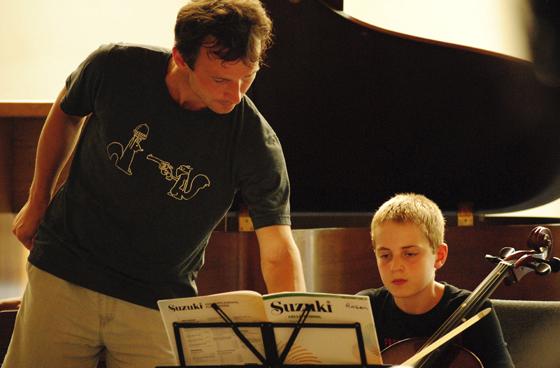
Last weekend I went to hear my friend Carol’s daughter, Hazel, play in her Suzuki violin concert. Amidst the sea of concentrated five-year-olds, Hazel’s smile radiated. Where the other children played, Hazel performed. You could tell that her interpretation of “Long, Long Ago” really meant something to her.
Afterwards, I told her mom what a joy it was to see a child clearly reveling in her performance. “She loves to play,” Carol proudly agreed. Her face suddenly fell. “But it’s a nightmare to make her practice. We’re at our wits end.”
Carol’s not alone. Most parents of young musicians, even those that love their instrument, sometimes have trouble motivating their kids to practice. But with a little imagination, practicing can be less monotonous and more fun. Try these games to break up your child’s practice routine and get their creative juices flowing.
Practice Circuit Training
The great violinist Itzhak Perlman stresses slow practice, saying “if you practice something slowly, you forget it slowly. If you practice something fast, you forget it fast.” He’s probably never had to practice with an 8-year-old. A change of pace and a little bit of adrenaline can make practicing more palatable, especially for particularly active children.
Break the piece into short sections of 2 or bars. Decide on 4 or 5 simple exercises, for example:
-Clap rhythm
-Say names of notes
-Play left hand
-Play right hand while counting out loud
-Play left hand while singing right hand
Take the first section, and have the student perform the whole set of exercises without stopping. At the end of the set, have them get up and do 10 jumping jacks. Then, move onto the next section and repeat.
Job Jar
If at first you don’t succeed, try it another way. The Job Jar is a great game for kids (and adults, too!) who are easily bored with the routine of practicing.
You’ll need a large jar and a bunch of popsicle sticks (you can buy these at the dollar store--no popsicles necessary!). Ask your child to help you brainstorm different ways of practicing, for example:
-Play every other measure
-Play left hand only
-Play while counting out loud
-Play with eyes shut
-Play right hand while tapping beat with left hand
-Play as softly as possible
-Play as loudly as possible
-Start from the very last measure and work forward
-Play as slowly as possible
-Play as quickly as possible
-Perform the whole piece
Come up with as many as you can, then write each task on a popsicle stick. During the practice session, have your child draw 10 popsicle sticks from the jar, performing each task as they go.
Practice Snakes and Ladders
A teacher I admire once told me, “it’s not how many times you play it, it’s how many times you play it RIGHT.” Research has concluded that the percentage of correct repetitions is one of the most important factors leading to musical progress. Here’s a game to help encourage accuracy.
Draw a simple gameboard with seven squares. The first square is the “Snake,” the last square is the “Ladder,” and the centre square is the Start.
Divide the piece into small sections of, for example, 4 bars. Place a coin or other marker on the Start space, and have your child play the first section. If they play it without any mistakes, they get to move the marker one space to the right; if they make a mistake, they move it one space to the left. Once the student makes it to the rightmost space, they climb the ladder, return to Start, and begin playing the next section. If they reach the leftmost space, they slide down the snake, return to Start, and practice the previous section.
Play continues until the student reaches the end of the piece.






